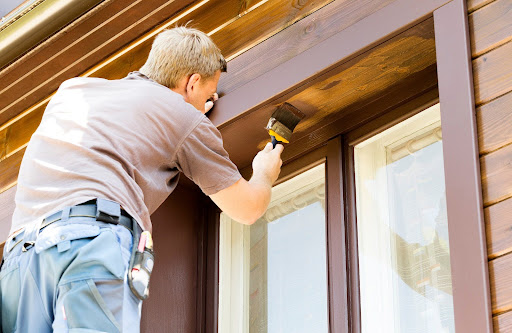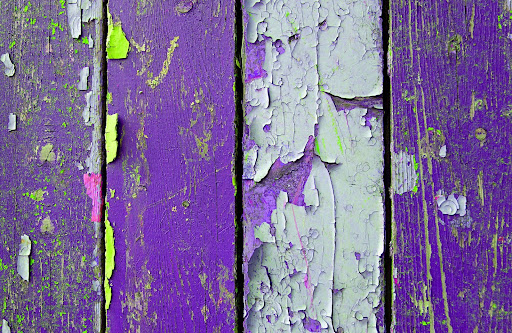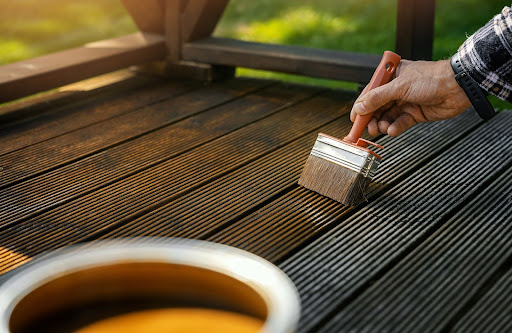
Many gorgeous homes have wooden exteriors, but what makes most of them appealing is having the right paint for the wood. In addition to curb appeal, you are also helping these exterior fixtures endure harsh outdoor conditions.
Why Should You Paint Wooden Exteriors?
You need to paint your wooden exteriors to protect them and make them last longer. A high-quality exterior paint job will create a weather-resistant, protective barrier for a wooden house exterior. It improves how your home looks aesthetically while helping the material last longer.
Common Issues with Exterior Wooden Paint
Before choosing the best exterior house paint for wood, homeowners should consider the common issues they face. Here are some factors that can cause paint failure for outdoor wooden surfaces.
Moisture Damage
Wood quickly absorbs water from the environment. If the water or moisture gets trapped under the paint layer, it can lead to bubbling, blistering, and peeling paint.
Before painting the surface, try to ensure you’ve treated the wooden surface properly. To avoid any moisture-caused damage, try to use primers to prevent this.
UV Radiation
Because of UV light, sunlight exposure can degrade on a molecular level. When this happens, the color fades, and the paint layer becomes chalky. The paint breaking down like this affects its appearance and protective ability. When paint degrades, the wood under it will be more prone to damage.
When choosing paint, remember that dark colors usually break down faster than lighter colors. Also, walls facing the south usually get more sunlight exposure. If you can, try to find UV-resistant paint for those parts.
Temperature Fluctuations
Temperature changes make wood expand and contract. This can result in the paint layer cracking and peeling, especially if it’s not flexible enough to move with the wood. This is especially concerning when the seasons change from hot to cold because the movement can create stress on the paint layer.
Bad Surface Preparation

For paint to properly adhere to a surface, you need to do the right prep work. If you don’t clean, sand, and prime your surface, the paint will fail to adhere correctly. This also means the paint won’t properly bond and will start peeling prematurely.
Before applying paint, you must ensure that the surface is free of dirt, old paint, or other residue. Failure to do this will result in the layer of paint lifting.
Priming is also an important step. It adds another layer of protection to the paint coat and helps prevent stains or tannins from reaching the new layer and bleeding through it.
The Secret to Long-Lasting Paint: Preparation and Product Choice
How long your exterior wood paint job lasts will depend on several factors, including surface prep and using the best outdoor paint for wood.
Surface Preparation
Correct surface preparation involves three things.
First, you need to clean the surface properly. Make sure there’s no dirt or debris preventing the paint from sticking. To clean the wood, use a pressure washer or scrub it with a bleach-water solution.
Now that the surface is clean, you need to repair any gaps. Fill any cracks and sand them down to a smooth, flat surface.
Lastly, you must apply some primer, especially if you’re working with bare wood. This helps make the pain stick better while acting as a moisture barrier.
Choosing the Best Paint for Outside Wood
Paint is not a one-size-fits-all solution. There are many types of paint. Choosing and using the proper one can make your exterior more appealing while making it more durable.
Here are the best options for exterior wood surfaces:
1. Acrylic Latex Paint
Acrylic latex is both tough and flexible, making it a top choice for exterior wood projects. It’s also resistant to cracking and peeling.
This type of paint uses a water-based formula, which makes it dry quickly and easier to clean. It also sticks to wood easily while staying water resistant.
This type of paint is typically used for exterior siding, trim, and fences, which require extra weather resistance.
2. Oil-Based Paint
Another hard, durable paint is oil-based paint. It sticks to surfaces well, and it lasts a long time. The only downside is that it takes longer to dry and can smell while still wet. You would also need a solvent to clean it up.
Nevertheless, it’s an excellent option for high-traffic areas, especially on doors and trims that experience frequent contact.
3. Solid Stain

If you do not like covering up the gorgeous wood grain, you can try using a wood stain instead. It preserves and enhances the natural lines found in wood.
Unlike paint, solid stain seeps into the wood instead of sitting as a layer on top. This eliminates the worry and risk of peeling, bubbling, and chipping. It’s perfect for wooden exteriors like decks and fences, as stains can withstand heavy foot traffic and extreme weather conditions.
How to Make Your Paint Job Last Longer
To ensure your exterior wood paint lasts as long as possible, follow these best practices:
1. Apply Multiple Thin Coats
Two or more thin coats adhere better and last longer than one thick coat. Thinner coats dry faster, reducing the chance of trapping moisture beneath the paint, which can lead to bubbling and peeling over time.
2. Choose the Right Time to Paint
Avoid painting in extreme heat, cold, or humidity. The ideal temperature range for painting is between 50°F and 85°F. Painting during mild weather ensures even drying and reduces the risk of premature cracking or peeling due to rapid expansion and contraction of the wood.
3. Inspect and Maintain Regularly
Perform annual inspections for peeling, cracking, or mildew, and touch up problem areas before they worsen. Small cracks or chips should be repaired immediately to prevent water infiltration that can lead to more extensive damage.
4. Use High-Quality Brushes and Rollers
Investing in good tools lets you have even coverage and better adhesion. If you have cheap brushes may shed bristles or leave uneven strokes, you may also be compromising the integrity of the paint job.
5. Consider a Topcoat or Sealer

If you live in an area with heavy rain or intense sun, an additional topcoat or clear sealant can enhance protection. A UV-resistant or waterproof topcoat helps preserve the color and prevents fading. It will also reinforce the paint’s durability against harsh environmental conditions.
The Right Paint for the Job
Choosing the best exterior paint for wood means that, apart from aesthetics, you need to think about longevity and protection. The proper paint type, along with proper preparations, can extend the life of your exterior wood surfaces.
If you’re unsure about tackling the job yourself, consider hiring a professional painter to ensure a flawless and long-lasting finish. Let Queen City Painting, a Charlotte painting company, help you out. Call us at 704-996-9266 or contact us online for a free quote today!
